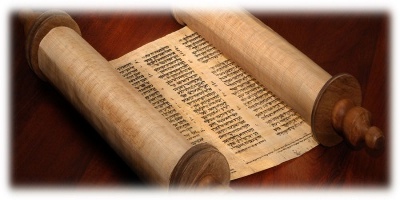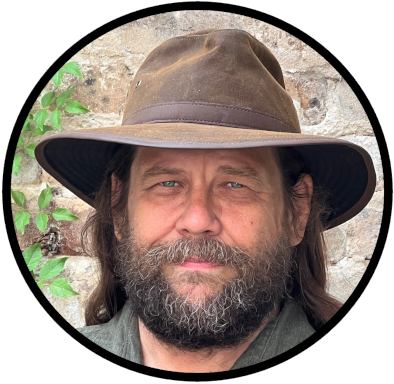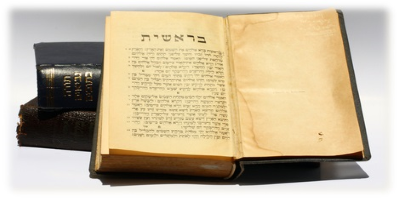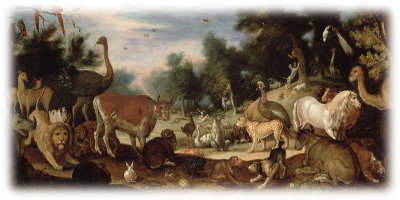There is a sense of excitement when one discovers something which is hidden to everyone else. I think we can all identify with that. "Hunt the Thimble" was a favourite game when I was a child and there was always jubilation when one found the thimble for which others were still searching. So I can well imagine how the first person to notice the hidden word patterns in Scripture felt when he saw them. Today the whole issue of hidden patterns, or 'codes' is a highly studied subject and, as with all things of God, has been copied and in many ways, perverted by satan.
One of the wonderful, complex and favoured word patterns used in literature is called the chiasm, or chiastic structure. It is called this because the pattern of the words or phrases (or in the case of Scripture, the verses, chapters or books) is such that they point to a central crux, or we might say, "X marks the spot". As the letter X, in Greek, is chi the pattern was called chi-astic. The pattern is made up of part 1 which is repeated in reverse order in part 2. So, ABBA would be a chiasm. ABCBA would also be a chiasm and, in this case, it would have a 'spot' to mark; C.
In Hebrew it is called an atbash (אתבש) structure because the aleph is mirrored by the tav (first and last letters of the aleph-bet)and the bet is mirrored by the shin (second and second last letters of the aleph-bet).
Rabbi David Fohrman has taught a fascinating series on the chiasm in Exodus and shows how, in the latter half of the book (from chapter 25 onward), there are chiasms within chiasms. For example, the word for 'assembled' or 'gathered', (ויקהל) appears nowhere in Torah until the people assemble while Moses is up the mountain, in Exodus 31:1. The next time it appears is in chapter 35:1, exactly three chapters later, when the people gather to hear the words of the Lord. These two occurrences, exactly, bookend the chapters in the middle, which are about the making of the golden calf. The first occurrence is between the instructions about Shabbat and the calf and the second between the calf and the second telling about Shabbat.
On a greater scale, the whole story of the people at the mountain, beginning in chapter 24 starts with a cloud descending on the mountain and ends with the cloud descending on the tabernacle. These two cloud events bookend that happens in between and those events themselves can be broken down into further events which are bookends for yet more events.
The Bible is littered with chiasms, but one which has always interested me is the fact that Torah is, in itself, a chiasm. As is noted elsewhere, on this site, there is a chiasm, consisting of a closed interval of 50 letters, in the books of Genesis, Exodus, Numbers and Deuteronomy spelling Torh, Torh, hroT, hroT (AABB) But in the book of Leviticus we find, not Torah, but the Tetragrammaton, YHVH, in a closed interval of 7 letters. So our chiastic structure is AACBB, which points us to the central book of Torah, Leviticus, as being the most important. The 50 letters point to Jubilee and the 7 letters indicate, "Rest, be filled, my oath is being satisfied (or fulfilled)". Jubilee and the seventh day are both about rest. What a strange thing to find in the book which is about slaughter, rules, regulations and WORK of the priesthood. Well, we'll see.
Accepting that Leviticus is where God wants our attention to be focused, in Torah, we then look at the structure of the book itself. It is laid out in another chiasm.
| Chapters | Subject matter | |
| 1-7 | Israel draws near to God. (Offerings and sacrifices) | |
| 8-10 | The priesthood is established. (Those who will lead worship) | |
| 11-15 | Health for God’s people. (The clean and the unclean) | |
| 16 | Day of Atonement. | |
| 17-22 | Holiness for God’s people. (What is holy and what is common) | |
| 23-25 | How the priests are to conduct their service. (The worship of God) | |
| 26-27 | How Israel is to live with God. (Punishments and vows) |
Now chiasm is showing us that the central book of Torah, God's teachings to his set apart people, is Leviticus and the central issue, of the central book, is the Day of Atonement. This, God is telling us, is the most important point I want to make to you in all my teaching......how you shall be atoned for. Also note, in Hebrew, Leviticus is Vayikra, which means, "He called". This is referring to God calling to Moses to come into his presence. In Hebrew there is conveyed a sense of loving calling, a gentle invitation, not a booming voice from on high, commanding. This is an invitation of love, from God to Moses, to enter his presence and receive his teaching on how atonement will take place.
To develop this concept further we need to know a little about the Hebrew marriage certificate; the Ketubah. Yes, this is a slight detour, but it is a scenic one. Ketuba was a lavish and beautiful document which, traditionally, contained five sections. The first contained the history of the bride and groom. The second, the personal and family history of the bride. The third, the personal and family history of the groom. The fourth, how the bride and groom met and the fifth, details of their respective responsibilities in their marriage. Each of these five sections corresponds to the five books of Torah. Torah is, in effect, a betrothal contract, written after the groom has 'called' to his prospective bride. At the centre of this betrothal contract is the crucial information on how the two shall become one, how she shall be as holy as he is holy, the information on the Day of Atonement.
If we next jump into the New Testament, to the Book of Hebrews, we will find that it is the 'unwrapping' of Leviticus. Although there are frequent references to a "new covenant" or an "old covenant", the word "covenant" is never there in the Greek. It simply says, "new" or "old". So if it is not a new or old 'covenant' to which the writer is referring, what can it be? It is to the new or old ’priesthood’. If you read through Hebrews with this thought in mind and remove every instance of 'covenant', you will see that is exactly what the Book of Hebrews is about. It is the elevating of the Book of Leviticus, from the physical priesthood, after the order of Aaron, to the spiritual priesthood, after the order of Melchizedek.
So what do we find at the end of all that convolution?
We see this :- The groom is calling to his bride, "Come to me, let me make you ready for our wedding. You must be holy and clean, as I am holy and clean, but as all earthly ways to achieve this are flawed and substandard, I, personally, will offer myself as your sacrifice; I will make you clean and holy". Now we understand the emphasis on rest. The groom has done all that is required for the bride to be able to be clean and holy; there is no work for her to do, all she needs is to avail herself of what he has made available. All she need do is pursue the deep relationship of a prospective bride with her proposed husband.
It is, says, Proverbs 25:2," the glory of God to conceal a matter, but the glory of kings to search out a matter". Digging deep in the rich soil of Scripture usually unearths a treasure, but the greatest treasure of all is the groom himself.
Jennifer H MacRae Howie
For Freedom Alone
FaceBook
Like what you’re discovering? Continue the journey from Bible reader to translator.
|






